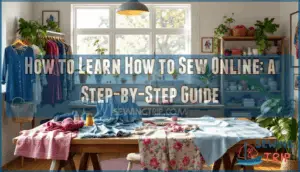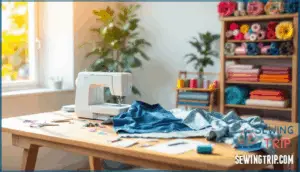This site is supported by our readers. We may earn a commission, at no cost to you, if you purchase through links.
 You can master a new skill without leaving your desk. Online sewing platforms have transformed how people learn to construct garments—offering expert instruction, pattern libraries, and communities that rival in-person classes. Whether you’re working with a $12 monthly subscription or free YouTube tutorials, the resources exist to take you from wobbly seams to well-fitted clothes.
You can master a new skill without leaving your desk. Online sewing platforms have transformed how people learn to construct garments—offering expert instruction, pattern libraries, and communities that rival in-person classes. Whether you’re working with a $12 monthly subscription or free YouTube tutorials, the resources exist to take you from wobbly seams to well-fitted clothes.
The challenge isn’t finding information; it’s knowing which platforms deliver real results, which techniques to prioritize, and how to structure practice time so your skills actually improve. With the right approach, you’ll move from observer to maker faster than you’d expect.
Table Of Contents
Key Takeaways
- Online sewing platforms (from $12/month subscriptions to free YouTube tutorials) provide expert instruction, pattern libraries, and community support that match or exceed traditional in-person classes for learning garment construction.
- Mastering four core techniques—straight and curved seams, darts for shaping, bias tape finishing, and closures like zippers and buttonholes—gives you the foundation to construct nearly any garment from sewing patterns.
- Consistent daily practice (15–30 minutes) combined with tracking progress through digital tools proves more effective than sporadic weekend marathons, turning shaky beginner skills into reliable techniques within weeks.
- Starting with actual wearable projects (simple knits, elastic-waist garments, or anything without complex closures) builds confidence faster than practicing on samples, while online community feedback accelerates learning beyond what solo courses can deliver.
Choose Your Online Sewing Learning Platform
The right platform can make or break your sewing journey. You’ll find options ranging from structured paid courses to free community forums, each with its own strengths. Here’s what you need to know before committing your time and money.
Paid Course Options (Sew It Academy, Skillshare)
Two proven paths lead you to online sewing education: structured courses and creative platforms. Sew It Academy offers 90+ sewing courses starting around $12–$18 monthly, guiding you from beginner basics to expert patternmaking with monthly updates. Skillshare runs about $165 annually for unlimited access to 800+ fashion classes.
- Membership benefits include new tutorials added monthly
- Course pricing fits most budgets with free trial options
- Skill levels range from absolute beginner to intermediate techniques
- Online tutors deliver step-by-step instruction through on-demand video
Both platforms democratize sewing education through flexible online learning. Users can find more information on Skillshare by checking its customer service reviews.
Community-Based Learning (PatternReview, Forums)
PatternReview and online sewing forums offer peer feedback from over 500,000 members who share pattern reviews and project guidance. Digital forums host 200+ weekly project posts where online mentors provide constructive critique—81% rated thorough.
Community engagement through sewing networks gives you access to 125,000+ pattern reviews and monthly challenges that keep 73% of sewers producing more garments.
Online learning through sewing community support costs nothing but delivers accountability that structured online sewing courses can’t match. Many sewers benefit from sewing online resources to improve their skills.
Budget Considerations and Free Trials
Most platforms give you access to free trials ranging from one to seven days before you commit. That’s your chance to test drive features without risking a dime. Ninety-eight percent of tutors provide free first sessions. Scholarship options exist too—Creative Sewing Textile Arts awards $1,000 annually.
If free courses suit your budget planning, FreeSewing offers unrestricted patterns and tutorials. Paid online sewing courses run between $79 and $249 for on-demand programs, or $40 per lesson in bundled packages.
PayPal processes most payment methods across platforms.
Master Essential Sewing Techniques Step-by-Step
Once you’ve picked your platform, it’s time to roll up your sleeves and build real skills. The techniques below form the backbone of garment sewing—master these, and you’ll gain the freedom to create almost anything.
Here’s where to focus your practice first.
Straight and Curved Seams
Straight seams might seem foolproof, but curved seams are where most beginners either find their rhythm or lose their nerve. Master both by practicing seam allowance control and choosing stable fabric.
Start with sewing basics like straight stitches on scrap material, then graduate to curved hems.
Proper seam finishing and the right sewing tools transform wobbly lines into professional garment construction—no matter what sewing patterns or sewing notions you’re working with.
Darts and Simple Shaping
Darts are the tailoring trick that turn flat fabric into something that actually hugs your body where it should. They’re simple wedge-shaped folds that add contour—think bust, waist, or hip shaping without pattern making wizardry.
Practice pinning and stitching from the wide end to the point, tapering smoothly. Master this sewing technique and you’ll nail garment fitting on any sewing patterns you tackle, transforming basic fabric choice into garment construction that actually flatters.
Bias Tape Finishing
Bias tape is your secret weapon for clean, polished edges that look store-bought, not homemade. It’s one of those finishing techniques that levels up necklines, armholes, and hems with minimal fuss—edge binding that hides raw seams like magic.
Here’s how to nail it:
- Choose your bias tape—pre-made from sewing notions or DIY from fabric
- Pin carefully around curves, easing without stretching
- Stitch twice—once to attach, once to secure the fold
Master this in any online sewing class and your sewing patterns will finally have that professional finish.
Closures and Fastenings
Zippers, buttons, and snaps turn fabric into something you can actually wear—but they’re also where most beginners freeze up. Online sewing classes break down each closure type so you can tackle any garment construction technique with confidence.
Start with invisible zippers on simple sewing patterns—they’re more forgiving than you’d think.
| Closure Type | Best For |
|---|---|
| Zipper Installation | Dresses, skirts, bags |
| Button Holes | Shirts, jackets, waistbands |
| Snap Fasteners | Baby clothes, quick closures |
| Hook Eyes | Bras, waistbands, formal wear |
| Magnetic Closures | Bags, adaptive garments |
Set Up Your Sewing Practice Routine
Learning to sew online won’t stick without a practice routine that fits your life. You need clear goals, the right course format, and a schedule you’ll actually follow.
Here’s how to build a sewing practice that keeps you moving forward instead of abandoning half-finished projects.
Define Your Sewing Goals
Before you pick up a needle or click "enroll," figure out what you actually want to make—because chasing every cute tutorial online is a fast track to fabric hoarding and half-finished projects. Get clear on your sewing objectives:
- Skill assessment: Know where you stand so you can learn to sew without drowning in complex techniques
- Garment planning: Pick real projects that match your creative vision and fabric selection
- Sewing education path: Choose an online sewing school or sewing course for beginners that fits your goals
Match Courses to Your Learning Style
Not all online sewing courses are created equal—some throw video after video at you, while others break things down frame by frame, and picking the wrong match means you’ll quit before you finish your first seam. Choose learning paths that fit how you absorb information.
Visual learners thrive with step-by-step video courses from an online sewing school, while hands-on types need real garment projects immediately.
Check student profiles and course formats before committing—free online education trials let you test adaptive learning approaches. A tailored curriculum beats a one-size-fits-all sewing course every time.
Create a Consistent Practice Schedule
You can’t wing your way to beautiful handmade clothes—random practice sessions lead to forgotten techniques and half-finished seams gathering dust in your closet.
Block out 15–30 minutes daily for your sewing routine rather than weekend marathons. Time management wins—consistent progress through a sewing course beats sporadic bursts.
Sewing discipline transforms sewing skills from shaky to sharp, turning sewing for beginners into real sewing education.
Track Progress With Digital Tools
Scribbling notes in a dusty journal won’t cut it—digital tools let you see your wins, spot patterns in your mistakes, and prove you’re actually getting somewhere with those seams. Sewing apps like ThreadLoops and Stash Hub manage fabric management and progress tracking, while platforms like Sew It Academy show completed lessons.
Online tools turn scattered sewing education into visible momentum—your digital sewing record becomes proof that your learn to sew journey is moving forward, not stalling out.
Start With Beginner-Friendly Garment Projects
The best way to build your skills is to work on actual garments, not practice samples. Start with projects that teach you real techniques while keeping frustration low.
Here’s how to choose makes that’ll give you wins early on.
Cut It, Stitch It, Press It, Finish It Method
Breaking down your first garment into four straightforward steps—Cut It, Stitch It, Press It, Finish It—turns what feels like a mountain into a manageable path you can walk again and again.
You’ll start with fabric selection and pattern making, then move through sewing techniques with real purpose. Each step builds confidence as you learn to sew garments that actually fit.
This method isn’t about theory—it’s practical sewing education that gets you creating wearable pieces fast.
Simple Knitwear Projects
Once you’ve nailed the basics with woven fabrics, knit fabrics open up a whole new world—softer, stretchier, and surprisingly forgiving for beginners ready to level up. Start with simple knit patterns like basic tees or loose tanks that don’t demand perfect garment fitting.
Your sewing machine needs a stretch stitch or ballpoint needle to manage the fabric’s give. Many online sewing courses include fashion education on yarn choices and sewing techniques that make working with knits less intimidating than you’d think.
Garments Without Complex Closures
Skip zippers, buttons, and snaps for now—garments with elastic waistbands or pull-on styles let you practice construction without wrestling closures.
Simple patterns like wrap skirts or drawstring pants give you real garment sewing techniques to master while keeping frustration low.
These quick makes build your sewing essentials toolkit and prove you can create wearable pieces fast—no fancy closures required.
Building Confidence Through Real Makes
Every finished piece—even a wonky first attempt—teaches you something no tutorial video ever could. Track your skill assessment and fabric selection choices in a sewing journal to see how far you’ve come. Project planning and confidence boosters show up when you move from learn-to-sew basics into real garment makes.
- A lopsided skirt hem that taught you to press seams properly
- That first elastic waistband you stretched too tight—but finished anyway
- The sewing pattern you modified after joining a sewing community for support
Join Online Sewing Communities for Support
Learning to sew online doesn’t mean going it alone. Online sewing communities connect you with experienced makers who’ve already tackled the challenges you’re facing. Here’s how to tap into that support and keep your momentum going.
Access Pattern Libraries and Reviews
Pattern libraries like CoPA-Online and Grace Vintage offer thousands of digital patterns and sewing archives spanning decades of vintage designs.
Sites like PatternReview and The Fold Line connect you to honest pattern reviews, helping you evaluate sizing accuracy and instruction quality before purchasing.
Browse Threadloop.app for hundreds of free and paid sewing patterns and designs, from T-shirts to skirts.
Online forums provide unbiased feedback on everything from Closet Core Patterns to classic techniques, so you can choose wisely and sew confidently.
Get Feedback From Experienced Sewers
Real mistakes—the kind you can’t unpick without learning something—are where the best feedback lives. Post your work-in-progress to forums like PatternReview or Reddit’s r/sewing for honest online critique. Experienced sewers spot tension issues, fitting problems, and technique gaps you’d miss alone.
This peer review creates a feedback loop that accelerates your sewing education faster than any solo sewing course. Find a sewing mentor through community threads, ask for expert guidance on tricky seams, and learn to sew with real support behind you.
Organize Your Patterns Digitally
Your pattern collection will spiral out of control fast unless you corral it into a digital system from the start. Platforms like ThreadLoops and Stash Hub let you catalog sewing patterns, track fabric organization, and build virtual workspaces that sync across devices.
This digital pattern management turns chaos into a searchable library—no more hunting through folders for that one sewing pattern creation you downloaded six months ago. Pair it with online storage for your sewing education and resources, and you’ve got a digital sewing setup that scales with your skills.
Stay Motivated With Monthly Challenges
Monthly challenges act like a shot of adrenaline for your sewing momentum—they push you past the "I’ll start next week" trap and into making real things on a deadline. Many sewing communities and Sew It Monthly Membership programs host challenge themes with built-in progress tracking and reward systems.
These sewing sprints turn learning to sew into a game you can actually win—plus, the shared motivation tips and sewing community and support keep you accountable when your enthusiasm dips.
Frequently Asked Questions (FAQs)
What skills do I need before starting?
No prior skills required. Basic sewing isn’t about perfect hand-eye coordination or fine motor mastery—it’s about patience level and willingness to learn.
Beginner sewing patterns and techniques teach spatial awareness gradually. Your sewing machine becomes your teacher.
How long does it take to learn sewing?
It depends on your goals and practice time. Beginner sewing skills take a few weeks with consistent practice.
Mastering sophisticated techniques requires months or years of dedicated work at the sewing machine.
What equipment and supplies should I buy first?
Start with a reliable sewing machine, basic thread colors, sharp fabric scissors, a seam ripper, pins, measuring tape, and a few fabric types to practice on during your sewing journey.
Can I learn to sew without a machine?
Like learning to ride a bike without training wheels, hand sewing lets you master the basics before adding machine power.
You can absolutely learn manual stitches, fabric selection, and sewing patterns by hand—it’s how your sewing journey starts. Sewing machine operation comes later.
How do I choose the right fabric?
Check fabric weight and drape against your project needs. Cotton works well for beginners learning Textile Arts basics.
Knits need stretch, wovens need structure. Match Fiber Blends and Texture Options to your garment’s purpose and your Sewing Machine’s capabilities.
Conclusion
You believed sewing required a brick-and-mortar classroom, a patient grandmother, or divine intervention. Wrong. Online platforms stripped away those excuses—now you’ve got expert instruction, pattern libraries, and communities waiting while you fumble with your seam ripper at 11 PM.
Learning how to sew online demands no mystical talent, just deliberate practice and a willingness to unpick mistakes without spiraling. Pick a platform, work through techniques systematically, and stitch real garments instead of hoarding fabric like a textile dragon. Your wardrobe won’t fix itself.
- https://www.cos.edu/en-us/Research/Program%20Review%20Narratives/Program%20Review-%20Fashion.pdf
- https://preply.com/en/blog/online-learning-statistics/
- https://canadacollege.edu/programreview/comprehensive-review-24-25/fashion-design-pr.pdf
- https://www.globusedujournal.in/wp-content/uploads/2020/05/Raynor-Ereje-GJEJJ20-PP-49-58.pdf
- https://gstreetfabricseducation.thinkific.com













